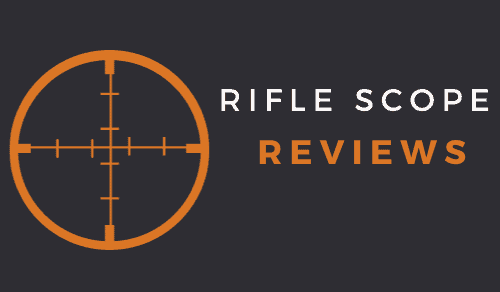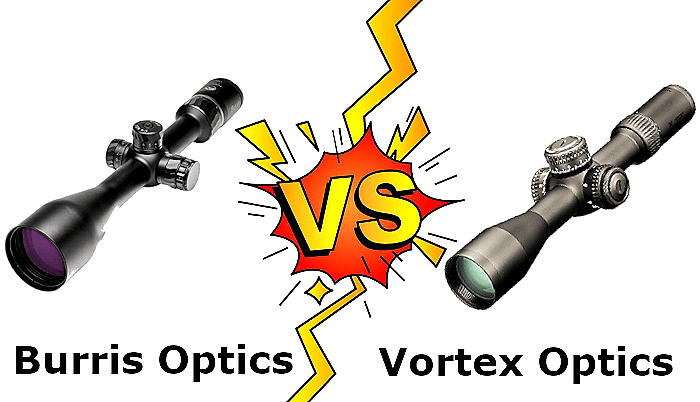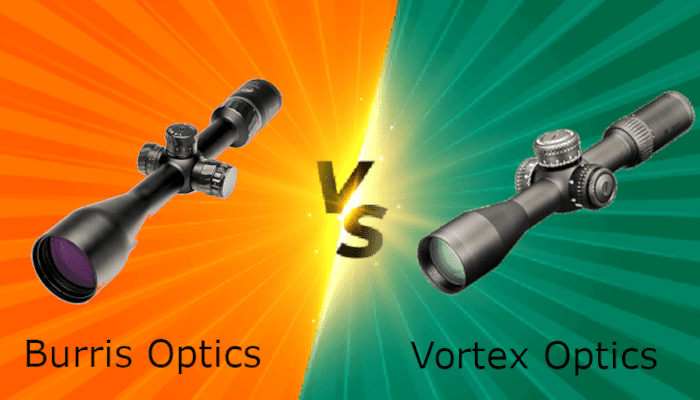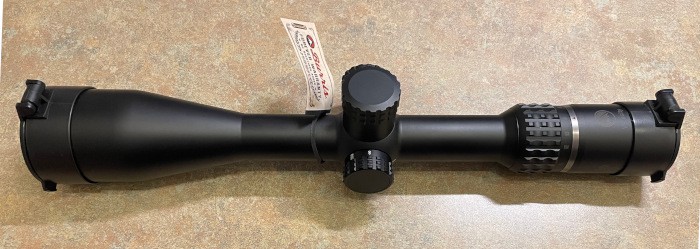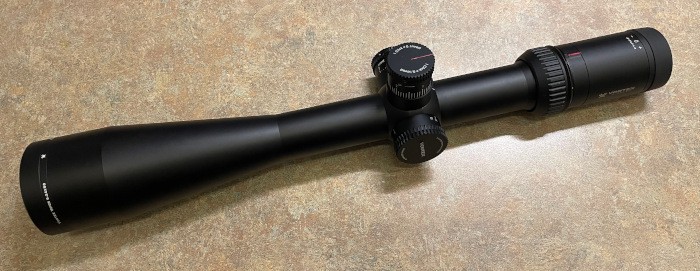As an Amazon Associate I earn from qualifying purchases. Amazon and the Amazon logo are trademarks of Amazon.com, Inc, or its affiliates.
With so many different rifle scope options on the market today, it’s not uncommon for prospective buyers to become overwhelmed with all the different brands, features, and power ranges. As such, I’m routinely asked (both in person at my day job and online through this website) to compare various brands at a high level. One requested comparison that comes up quite a bit is a comparison of Burris vs Vortex rifle scopes. In this post, I will go over both optical brands and then compare each brand on several key comparison points.
Remember that this comparison is solely based on my experiences with both brands, so take the information with a grain of salt.
Burris Scopes vs Vortex Scopes
Over the years, I’ve tried several different comparison formats and different comparison points. I finally settled on the following points of comparison, as the reader’s feedback on this format has been very positive. The topics and sub-topics that I follow with these types of comparisons include the following:
- Comparison of Scope Offerings
- Comparison of Optical Quality
- Reticle Options
- Warranty Programs
- Country of Manufacture
- Costs
- Value
Let’s dive deeper into each topic.
Comparison of Scope Offerings
When comparing one brand to another, I believe it’s crucial (and fair) to compare based on an apples-to-apples format when possible. In other words, I want to compare one brand’s entry-level scopes to another brand’s entry-level riflescopes.
To follow the apples-to-apples format, I break the scopes from each manufacturer into categories that are loosely based on the MSRP. For this comparison format, I generally use the following categories:
- Entry-level
- Mid-Range
- Upper Mid-Range
- Top End
- Specialty Scope models
Let’s look at comparing both brands within each category:
Entry-level Scopes (Up to $350)
Burris and Vortex both feature a few different scope families that meet the classification of an entry-level scope based on the $350 MSRP.
Using the $350 MSRP limit, Vortex has four series of scopes meeting the entry-level criteria. Those entry-level scope lines include:
- Sonora
- Copperhead
- Crossfire II (although a few of the Crossfire II models with illuminated reticles feature an MSRP over $350)
- Diamondback (5 scope models within the Diamondback series feature an MSRP under $350)
Within the Burris line of scopes, the Droptine and original Fullfield scopes were Burris’s entry-level scope offering. However, Burris has updated the original Fullfield scopes to new series called the Fullfield E1 and Fullfield IV.
Using the $350 price point, the following Burris optics meet the entry-level definition:
- Droptine (the entire line)
- Fullfield E1 (the whole line except for the E1 6.5-20×50 models, which have an MSRP just over the $350 mark)
- Fullfield IV (Only the 2.5-10×42 and 3-12×42 models)
After tallying up the numbers, Burris features 16 scopes in the entry-level category, while Vortex has 28 models in the entry-level grouping. From a comparison standpoint, Vortex features a much more robust offering in the entry-level category. In addition to offering more individual scope models in this price range, they also feature a more significant number of reticle options compared to Burris.
From an optical perspective, I’d say that the entry-level Burris optics offer slightly better glass compared to the entry-level Vortex models. In addition, I’d also say that the Burris scopes in this category feature eye relief that is less critical than the Vortex optics.
From a power range perspective, Vortex offers a more extensive range of magnification options compared to Burris. For example, Vortex has 11 different magnification options in this category, while Burris only has 2 (two) power range options with an MSRP at or below $350.
However, both companies feature some magnification configurations that are unique to each brand. For example, Burris offers a 4.5-14 magnification range, while Vortex provides a 4-12 configuration.
Another area where Vortex shines in this price range involves its focal plane options. While most of the Vortex scopes in this category are second focal plane, they also offer a few first focal plane options. Burris only features second focal plane (SFP) scope options at this price point.
From a tube size standpoint, Burris only offers 1-inch tube models in this grouping, while Vortex features 1-inch and some 30mm models in their entry-level models.
Based on all the factors discussed above, I’d name Vortex as the clear winner in this grouping.
Mid-Range Scopes ($351 – $700)
Traditionally, the mid-range and upper mid-range price points are the most competitive as those markets are the fastest growing part of the sporting optics market. This growth has led to a substantial increase in the number of scope models offered in this price range.
Looking at the Vortex line, the mid-range optics in the $351 – $700 range include the following scope series:
- Diamondback
- Diamondback Tactical
- Venom (which currently only features a single scope model)
- Strike Eagle (only the 1-6×24 and 1-8×24 models)
- Viper (only the Viper 6.5-20×50 PA model)
- Viper HS (only the 2.5-10×44 scope).
Within the Burris line of riflescopes, the mid-range models in the $351 to $700 MSRP range are the following:
- Fullfield E1 (only the 6.5-20×50 option)
- Fullfield IV (All models except the 3-12×42 and 2.5-10×42 models)
- Signature HD (All models except the 5-25×50 models)
- RT-6 (Which only features 1 model)
Burris Optics has a total of 12 scope models in the mid-range price points, while Vortex offers 13 scope models in this price range. In the mid-range category, these two brands are nearly dead even regarding the range of scope options.
From a quality of optics perspective, I’d rate Burris and Vortex nearly even in this grouping because the Vortex Optics models in this price range feature much better glass compared to their entry-level models.
Both brands appear to offer a very similar set of power magnification options within this price point. However, both brands also have some power options that do not overlap between the brands. For example, within this price range, Burris offers a more significant number of scopes, and those models seem to be more geared toward hunting. On the other hand, many of the Vortex scope models in this group appear to be more geared toward long-range shooting.
Most (but not all) of the Vortex scopes in this group feature a custom turret option where Vortex partners with Kenton Turrets for made-to-order aftermarket turrets that are BDC based. Burris offers a similar program for most (but not all) of the scope’s series included in this category. However, Burris does their custom turret work in-house versus partnering with a custom turret maker.
In terms of scope tube sizing, both brands feature scopes in 1-inch and 30mm configurations within this category.
Upper Mid-Range Scopes ($701 – $1200)
For this post, the upper mid-range category includes riflescopes with an MSRP between $701 and $1200. As seen with the mid-range scope market, the upper mid-range market is also becoming extremely competitive.
Within the Vortex line of scopes, the upper mid-range models in the $701 – $1200 price range include the following scope series:
- Strike Eagle (Only the 1-8×24 FFP and the 5-25×56 FFP models)
- Viper HS (Only the 4-16×44 and 4-16×50 models)
- Viper HST (All models)
- Viper HSLR (Only the 4-16×50 model)
- Viper PST Gen II (Only the 1-6×24, 2-10×32, and 3-15×44 models)
Within the Burris line of scopes, the upper mid-range models in the $701 to $1200 MSRP range are the following:
- Signature HD (Only the 5-25×50 models)
- Veracity (All models)
- RT Long Range (All models)
- XTR II (All Models)
Within this price range, Vortex offers a total of 12 scope models in the upper mid-range price points, while Burris offers 17 scope models that fall into the $701 to $1200 MSRP price point. In this price range, Burris offers a wider range of scope choices.
Although the glass quality between the two brands is quite comparable in this category, I’d give Vortex a slight edge in optical quality. And I do mean a very slight edge, as the Burris optics in this price range feature pretty good glass for the money. I’d also give Vortex a slight edge in the reticle choices as I find their reticle options more versatile compared to the Burris reticles.
In this price range, Burris has models built for hunting and long range shooting, but the bulk of the Burris scopes in this category are marketed toward the hunting market. On the other hand, the Vortex scopes in this price range appear to be focused on the long range, precision, and tactical shooting markets.
This is also the category where Burris begins to offer FFP models, while Vortex has FFP options in nearly every grouping I’ve discussed so far.
As seen in some of the previous groupings, nearly all the scopes in this category can accept aftermarket BDC-based turrets.
Top End Scopes ($1201 and up)
The riflescopes in this grouping include the top-of-the-line scope offerings for each brand. In addition, nearly every scope in this category is built for a semi-specialized purpose, such as long range shooting, long range competitions, long range hunting, and tactical precision-based shooting.
In the Vortex Optics line of scopes, the top-end models in the +$1201 price range include the following riflescopes:
- Viper HSLR (Only the 6-24×50 FFP model)
- Viper PST Gen II (Only the 3-15×44 FFP, 5-25-50 FFP, and 5-25×50 SFP models)
- Golden Eagle HD (which consists of only one scope in this series)
- Razor HD LHT (All models)
- Razor HD Gen-II E (All models)
- Razor HD Gen II (All models)
- Razor HD Gen III (All models)
For Burris Optic, the top-end models in this price range are these:
- Eliminator series (All models)
- XTR III (all models)
- XTR Pro (All models)
When this post was written, Vortex offered 24 scope models in the top-end category, while Burris offered nine scope models with an MSRP of $1201 or more. In this price range, Vortex features a much larger scope offering.
In addition, to offering more scope options at this price point, Vortex also offers more expensive scopes from a pricing standpoint. For example, Burris offers three riflescopes with an MSRP exceeding $2000, while Vortex has three models with an MSRP exceeding $3500. Additionally, the most expensive scope option in the Burris line has an MSRP of $2999, while the most expensive Vortex scope has an MSRP of $3999.
While Burris has a better-than-average offering in the +$1201 price range, Vortex has a much broader and more specific offering in this category.
Specialty Scopes
Specialty scopes is a term used to describe scope models designed or marketed for a specific purpose. Examples of specialty scopes include:
- Crossbow scopes
- Dedicated shotgun or muzzleloader scopes
- Dedicated rimfire scopes
Burris specialty scopes
Burris Optics offers several scope models designed for a specific purpose. Those models include the following:
- Scout optics
- Handgun optics
- A complete laser scope line with an integrated laser rangefinder and ballistic calculations
- AR scopes for CQC
- Dedicated long-range optics
Vortex specialty scopes
Vortex Optics also features several scopes that are made for specific uses, including the following models:
- Rimfire scopes
- Scout scopes
- Crossbow scopes
- AR-platform optics
- Dedicated long-range optics
Both brands feature a comparable offering for specialized scope models, but Burris offers an option that Vortex does not: a scope with an integrated laser rangefinder and integrated bullet drop compensation calculations. However, when comparing the number of specialized riflescopes produced by each optical brand, Vortex is the clear winner as they have a broader offering in this category.
Comparison of Optical Quality
For the most part, the brightness, sharpness, and coloring of the image seen via a scope are commonly referred to as the overall optical quality. However, there is a great deal of room for debate on the subject of optical quality due to its being so dependent on each individual’s perception and opinion.
That being said, my thoughts on a scope’s optical quality or glass quality are based on my experience in the sporting optics industry and my experiences from a lifetime of shooting. However, these are just my opinions, so take them at face value.
Comparing the entire Vortex line to the Burris line, I would give the edge in optical quality to Vortex across the entire line. However, there are areas where Burris offers better quality glass. For example, as I mentioned before, I would rate Burris Optics as having slightly better optics in the entry-level category of scopes.
However, comparing the entire line of scopes from one brand to another, I’d give the edge to Vortex.
It’s worth noting that while Burris is the older, more established of the two scope brands, they historically were more focused on the hunting optics market. Over the last few years, Burris has expanded their scope offerings to compete at the higher end of the market. However, Vortex has always been a fairly strong contender in the higher-end optical market, so Burris is still a little bit behind in that part of the market.
Now, does this imply that it is better to invest in a Vortex scope as opposed to a Burris scope? Not always. When looking for a riflescope, the quality of the glass is unquestionably one of the most significant factors to consider; nevertheless, it is not the only factor.
Reticle Options
Regarding reticle options, both Vortex and Burris feature a range of reticles designed for different uses.
If you only considered the total number of reticle options provided by each scope maker, Vortex Optics would come out on top because they offer a significantly greater variety of reticle patterns than Burris.
Within the entry-level and lowered powered magnification models, Vortex offers their very popular V-Plex reticle (which is Vortex’s version of a standard duplex) and their Dead-Hold BDC reticles.
Most of the Burris scopes in this same grouping are equipped with either their Ballistic Plex reticle or their Plex reticle. I like the Burris Ballistic Plex reticle as it can be used as a duplex-style reticle or as a BDC-type reticle. The Vortex Dead-Hold BDC and Burris Ballistic Plex reticle are very similar in many ways.
In the mid-range power magnification, Burris continues with a focus on hunting-style scopes, so most of the Burris reticles in this grouping are geared toward hunting. Vortex takes a bit different approach since their scope offering in these mid-range powers is split between hunting applications and long range shooting options. The Vortex reticles in the mid-power magnification range keep the Dead-Hold BDC and V-Plex reticles but also add some longer-range reticle options, such as the EBR-4 and Mil-Dot reticles.
In the higher magnification ranges, both brands migrate away from hunting-based reticles and begin to focus on more specialty reticles built for long range and precision shooting.
Warranty Programs
As part of my head-to-head comparisons between scope brands, I always look at the warranty program for each brand. If the warranty coverage doesn’t interest you, skip to the next comparison section.
Let’s start looking at the warranty program for these two brands:
Burris Optics Warranty
Burris offers a warranty program called their “Forever Warranty,” which is basically a lifetime warranty. Burris previously called it a lifetime warranty but has now eliminated the “lifetime” verbiage and replaced it with “Forever.”
The Burris warranty program is actually a pretty strong warranty, as it covers the optic forever and does not require any warranty registration. In addition, the warranty is advertised as “no questions asked” and does not require a receipt or proof of purchase for warranty coverage.
Also, the Burris warranty on the product automatically transfers from owner to owner, which is a big plus for me. I don’t particularly appreciate buying a used scope and then having to register it with the manufacturer to continue the warranty coverage.
The Burris warranty program requires that the owner pay the shipping charges to get the optic to Burris for repair, then Burris will cover the shipping costs to return the scope to the owner.
In a perfect world, I’d prefer that they offer a pre-paid label for the return, but that’s probably asking a bit much.
My experience with Burris’s warranty program is limited to only a few returns. However, all those warranty claims were handled quickly and professionally without any undue hassles. Based on my experiences, I’d rate the Burris warranty as a pretty solid program.
Here’s one area of the Burris warranty that may be worth noting:
“The Burris Forever Warranty does not cover loss, theft, deliberate damage or cosmetic damage that does not hinder the performance of the product.”
This means that Burris will not warranty a scope that has been painted or professionally coated with Cerakote or Duracote. I spoke with Burris customer support, who confirmed that painting a riflescope typically voids the warranty coverage.
Vortex Optics Warranty
The warranty that Vortex provides is referred to as their “VIP warranty,” where “VIP” stands for “Very Important Promise.” I would rate their warranty program as one of the best warranty programs available in the sports optics industry.
The Vortex warranty is an unlimited lifetime warranty that can be transferred from owner to owner and does not require any registration from the original owner or the 5th owner. The warranty on a Vortex product does not require evidence of purchase, a warranty card, or a receipt. For the duration of the product’s life, Vortex will, at no additional cost to you, either repair or replace the product.
One great part of Vortex’s warranty is their willingness to repair or replace a non-illuminated optic, regardless of how it was damaged. Dropped the rifle in a fall; no problem, it’s probably covered. Truck caught on fire, and the scope was burned; no problem, it’s probably covered.
I’ve also had the opportunity to make use of the Vortex warranty both for myself and for customers at the day job that I currently have, and the process has always been relatively straightforward and uncomplicated.
Another positive point about the Vortex warranty: It covers any scope, even if it’s been painted or cerakoted. Given the increased popularity of cerakoting optics for added protection, this is a big plus for Vortex in my book. However, there are limitations to the painted scopes from a warranty standpoint. The warranty verbiage says the following: “The VIP Warranty does not cover loss, theft, deliberate damage or cosmetic damage that does not hinder the performance of the product.”
So, any situation where the scope has been painted but still functions correctly would be covered. However, if you painted your scope and the turret caps are now permanently attached to the optic and won’t come off, that’s not covered under warranty (and that’s a real example from a customer at my day job).
Which brand has the Better Warranty?
While both Burris and Vortex offer excellent warranty programs that are far better than most, I’d give Vortex an edge for the following reasons:
- The Vortex warranty is more inclusive and covers a broader range of issues.
- The warranty from Vortex also covers optics that have been painted to coated in a protective covering as long as the optical functionality isn’t compromised.
To be clear, I’m not bashing the Burris warranty in any way, as it’s an excellent warranty program; I just feel that Vortex offers slightly better coverage.
Country of Manufacture
The country of manufacture is a fancy term to describe where a product is produced or manufactured. The source country of a particular product is important for two reasons:
- It plays a role in determining the perceived quality of the product.
- It can play a role in supporting the U.S. economy
Case in point, of all the optically-related questions I’m asked on a daily basis, none are more common than the “Is this scope made in America?”
Let’s look at where each of these brands is manufactured:
Vortex Optics
Vortex Optics was founded in the U.S. and is headquartered in Wisconsin. Even though they are based in the U.S., approximately 90% of their riflescopes are manufactured in China or the Philippines. Most of their entry-level models are sourced from China, while the Vortex mid-range optics are built in the Philippines. Only Vortex’s high-end scope models (like the Razor series) are manufactured at the Vortex facility in WI from components sourced from Japan.
Vortex has performed exceptionally well in the sporting optics industry, with the bulk of its sporting optics being manufactured overseas. I’m convinced that Vortex’s fantastic warranty program, reasonable price points, and premier customer service have played a significant role in that success.
Burris Optics
Since Burris Optics was founded in 1971, they are a much older and more established company compared to Vortex. Up until 2002, all the Burris scopes were manufactured and assembled in the U.S. However, as the production costs in the states continued to rise, Burris was forced to migrate the manufacture and production of scopes overseas.
However, Burris took a completely different approach to migrating production to an overseas facility. The traditional approach to transitioning a manufacturing program to an overseas location involved sending the selected vendor the specifications for each scope. Instead, Burris decided to take a different approach. Once they had selected an overseas vendor in the Philippines, Burris duplicated all their tooling and processes, then sent them to the optical facility handling the production. This approach ensures that the Philippine-made scopes were built with the exact tolerances as the U.S.-built models.
In addition, Burris opted to maintain control of the quality control process as the completed scopes are sent from the Philippines facility to the Burris U.S. facility for final inspection, testing, and packaging. This approach has ensured that the quality has remained consistent.
Today, about 95% of the Burris scope lines are produced in the Philippines. The higher-end lines like the XTR, XTR II. XTR III, and XTR Pro are assembled at the Burris facility in Colorado from components sourced from Japan.
Scope Costs
I’ve already touched on this topic a little bit previously, but here’s a deeper dive.
Using the MSRP as a comparison point, there are some notable areas of difference between these two scope brands. For example, in the entry-level groupings, Vortex has a more extensive offering of riflescopes but is less expensively priced than the comparable Burris optics in that category.
However, as I move into the mid-range and upper mid-range categories, the Vortex MSRP costs begin to outpace the Burris costs. The most significant difference in MSRP pricing between the two brands occurs in the high-end category, where Vortex has models costing significantly more than the most expensive Burris optic.
It’s worth noting that I’m using MSRP pricing as a comparison point, and the actual real-world pricing may be significantly less. Once vendors have adjusted the pricing down to real-world pricing, it’s possible that the costs are more even in the top-tier scope models.
Another point worth mentioning: Pricing is only one factor in the buying decision. Just because a Vortex scope costs more than a comparable Burris scope doesn’t automatically mean that the Vortex model is a better option. There are other factors to consider, such as:
- Power range
- Reticle
- Weight
- Desired Usage
- Parallax
While price will always be a factor in the buying decision, I always recommend that you look at all the factors before making a purchase.
So, Which is a Better Scope: Burris or Vortex?
Honestly, there are far too many potential variables to answer that question across the board.
The answer really depends on factors that are important to the buyer. For me, those factors include the following:
- Desired magnification range
- Your budget
- Desired features
- Desired reticle
That being said, I will offer these high-level suggestions:
- If you’re in the market for an illuminated reticle, I’d focus on Vortex, as they offer more illuminated reticle options than Burris.
- If the warranty program is important, either of these brands would be a viable option, although Vortex has a slightly better warranty.
- If you’re on a budget and want to spend as little as possible, then Vortex will be your best bet, as they have the least expensive scopes between the two brands.
- If you’re shopping for a scope that is made in America, about the best you’ll get between Vortex and Burris are optics that are assembled in the U.S. In addition, those assembled in the U.S. models will feature scope components sourced from outside the country and will be the most expensive models within each brand.
- If you’re in the market for specialized scope or one that is designed for a very specific purpose, then either brand would be a good fit.
- If money is no object and you’re after the best optical quality you can get between these two brands; then you’ll want to look closely at Vortex. They have better quality glass, but it comes at a higher cost.
FAQS
Here are some frequently asked questions that I see regarding the Burris versus Vortex comparison:
Is Burris a good Scope?
Burris Optics has been around since the early 1970s and produces very good riflescopes for the money. Burris primarily focuses on hunting scopes but has entered the long-range and tactical scope market in the last few years. The Burris line of scopes features models to cover almost every type of hunting or shooting situation. While the Burris line isn’t the cheapest scope on the market, they are a top-quality optical provider with prices that are in line with their competition.
Where can I find a Burris Black Diamond scope?
Introduced in 2000, the Burris Black Diamond series was Burris’s top-of-the-line scope model for many years. The Black Diamond models featured European quality glass for top-quality resolution and clarity. Unfortunately, Burris opted to phase out the Black Diamond series of scopes at the end of 2012 and replace them with new series. Since the Black Diamond models have been out of production for 10+ years, the secondary marketplaces (like eBay) are about the only place to find any for sale.
Is there a Burris rangefinding scope? If so, can you provide some information about it?
Burris does offer a rangefinding scope called the Eliminator Laserscope. This scope series uses a built-in laser rangefinder to determine the distance to the target and also features an onboard ballistic calculator that helps determine any potential hold-over based on factors such as the caliber, bullet speed, bullet weight, etc. The Burris Eliminator scopes are Burris’s top-end line of hunting scopes and are currently offered in 5th-generation versions.
Does Vortex Optics offer custom turrets?
Vortex Optics does have a custom turrets program that is offered through a partnership with a well-known aftermarket turret provider called Kenton Turrets. Vortex does not build or create the turrets in-house, but they farm the turret manufacturing out to Kenton Turrets. As a result, most Vortex scopes (but not all) can be equipped with the aftermarket Kenton Turrets. These turrets are designed for bullet drop compensation (commonly called BDC) based on the caliber, bullet speed, bullet weight, etc.
Hopefully, the information provided helped clarify the differences and similarities between the Burris and Vortex line of riflescopes.
I’ve been working in the firearms and sporting optics industry for over 20 years, with a personal and professional interest in all things related to rifle scopes, Through a combination of work experience, formal training, and personal experiences, I have extensive experience mounting, testing, and evaluating different rifle scope models across most major optical brands.
